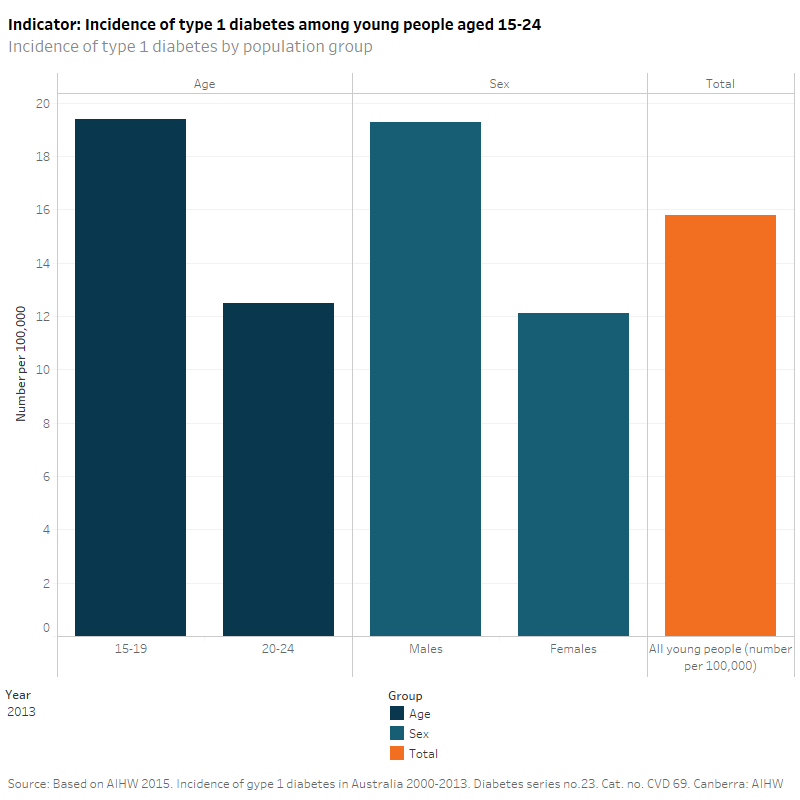Type 1 diabetes
Why is incidence of type 1 diabetes important?
Type 1 diabetes is a chronic autoimmune condition that develops when the immune system destroys the insulin-producing cells of the pancreas. It typically develops during childhood and adolescence, although the condition can occur at any age (Craig et al. 2011). Type 1 diabetes is characterised by the almost complete inability to produce insulin, meaning that those affected require life-long insulin replacement for survival (Shaw & Tanamas 2012). The inability to produce insulin means that glucose cannot be adequately taken up by the body’s cells (where they would be stored for future energy use) which results in elevated blood glucose levels. While the cause of type 1 diabetes is unknown, it is believed to arise from a complex interaction of genetic predisposition and environmental factors. While there is no cure for the condition, it can be managed through a careful balance of diet, exercise, regular blood glucose testing and administration of insulin to keep blood glucose levels within a safe range.
Do rates vary across population groups?
In 2013, there were 490 new cases of type 1 diabetes among all young people aged 15–24 in Australia, which translates to an incidence of 16 per 100,000. Young people aged 15–19 were almost 1.5 times as likely as 20–24 year olds to be newly diagnosed with type 1 diabetes, with incidences of 19 and 13 per 100,000 respectively. Males were also around 1.5 times as likely to be newly diagnosed with type 1 diabetes as females (19 and 12 per 100,000 respectively).
In the period 2005–2013 there were 105 new cases of type 1 diabetes among Indigenous young people aged 15–24. However, data quality issues concerning Indigenous status in the NDR, make it difficult to provide accurate comparisons of Indigenous and non-Indigenous rates (See ‘Notes’ below for more information).
Has there been a change over time?
Incidence of type 1 diabetes among young people aged 15–24 remained relatively stable from 2000 to 2013, with rates remaining 15 per 100,000 young people per year. For different population groups over this period rates of new diagnoses remained largely unchanged for 15–19 year olds (17 per 100,000), 20–24 year olds (13 per 100,000), males (18 per 100,000) and females (12 per 100,000).

It should be noted that the incidence of type 1 diabetes is much higher in the 0-14 than in the 15-24-year-old age group (see AIHW 2015 for more information). This means that prevalence of type 1 diabetes among 15-24 year olds would be substantially higher than the incidence rate. Regular national prevalence data for 15-24 year olds are not currently available, although are expected to be in the future at which time this indicator will be reviewed.
In the period 2005–2013, Indigenous status was not stated in 16% of records, which made it difficult to provide accurate comparisons of Indigenous and non-Indigenous rates. Aboriginal and Torres Strait Islander people may also be under-represented on the National Diabetes Services Scheme (NDSS) from which data for the National Diabetes Register is sourced. This may be because Indigenous people choose not to identify themselves when they register on the NDSS, or because there are low rates of registration among Indigenous Australians due to the ability of Indigenous people to access diabetes supplies through other targeted programs.
National (insulin-treated) Diabetes Register 2013, with calculations based on NDR data reported in AIHW Incidence of type 1 diabetes in Australia 2000-2013.
Data quality statement: AIHW METeOR
AIHW (Australian Institute of Health and Welfare) 2015. Incidence of type 1 diabetes in Australia 2000–2013: supplementary detailed tables. Diabetes series no. 23. Cat. no. CVD 69. Canberra: AIHW. Viewed 21 July 2015.
Craig M, Twigg S, Donaghue K, Cheung N, Cameron F, Conn J et al. 2011. National evidence-based clinical care guidelines for type 1 diabetes in children, adolescents and adults. Canberra: Department of Health and Ageing
Shaw, J, Tanamas, S 2012. Diabetes: the silent pandemic and its impact on Australia. Baker IDI Heart & Diabetes Institute 2012. Viewed 23 June 2015.


